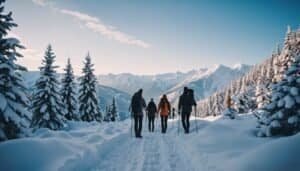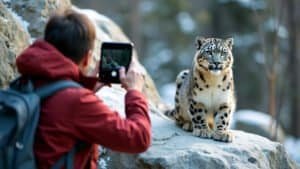Introduction
Snow leopard tourism has emerged as a vital economic driver in remote mountain regions where these elusive big cats roam
This article delves into the multifaceted role that snow leopard tourism plays in boosting local economies, from generating employment and supporting small businesses to enhancing infrastructure and fostering wildlife conservation efforts
Additionally, we’ll explore how tourism impacts local cultures, the challenges faced by these communities, and the strategies needed to ensure that snow leopard tourism remains a sustainable and beneficial activity for years to come
The Economic Impact of Snow Leopard Tourism
Snow leopard tourism has become a significant economic asset for communities living in the remote and often harsh environments where these elusive cats are found. These areas, typically located in parts of the Himalayas, Central Asia, and Siberia, are characterized by their rugged terrain and limited economic opportunities
Tourism centered around snow leopards offers a unique and valuable source of income for local populations, who have historically relied on subsistence farming, herding, and limited trade. By attracting international visitors eager to glimpse these rare animals in their natural habitat, snow leopard tourism is helping to transform local economies
Contribution to Local Employment
One of the primary ways snow leopard tourism benefits local economies is through job creation. The tourism industry in these remote regions requires a variety of services, including guides, porters, cooks, drivers, and accommodation providers
Many of these positions are filled by locals, providing them with a stable source of income that is often significantly higher than what they might earn from traditional livelihoods
According to a study by the Snow Leopard Trust, communities engaged in eco-tourism activities related to snow leopards have seen a marked increase in employment opportunities, particularly for youth and women who may otherwise have limited job prospects (Snow Leopard Trust, 2020)
Local guides, often with deep knowledge of the terrain and wildlife, play a crucial role in these tourism experiences. Their expertise is indispensable for tracking snow leopards and educating tourists about the ecosystem. This not only ensures that tourists have a safe and enriching experience but also empowers the guides by recognizing and valuing their skills
Furthermore, training programs aimed at improving language skills, wildlife knowledge, and hospitality standards are becoming more common, further enhancing employment prospects for locals
Benefits for Small Businesses
Snow leopard tourism also stimulates local economies by supporting small businesses. Tourists visiting these regions often spend money on a range of goods and services, from lodging and food to crafts and souvenirs
Local artisans and shop owners benefit directly from this influx of spending, which helps to diversify income sources in areas where economic opportunities are otherwise limited
For instance, traditional handicrafts, which might have struggled to find a market, are now in demand as tourists seek authentic and locally-made souvenirs. This not only provides a revenue stream for artisans but also helps preserve cultural heritage by sustaining traditional crafts
A study conducted by the Global Snow Leopard and Ecosystem Protection Program (GSLEP) found that areas with snow leopard tourism initiatives saw a 15-20% increase in sales of local products within a few years of establishing tourism operations (GSLEP, 2021)
In addition to direct spending, snow leopard tourism encourages the development of local infrastructure, such as guesthouses, restaurants, and transport services, which are often owned and operated by community members
These businesses contribute to a multiplier effect, where the economic benefits of tourism are felt widely throughout the community
Influence on Infrastructure Development
The influx of tourists also drives infrastructure development in these remote areas
Improved roads, better communication networks, and enhanced public facilities are often the result of the growing need to accommodate tourists. While these developments primarily serve visitors, they also benefit local residents by improving access to essential services and markets
For example, the establishment of eco-lodges and community-based tourism centers often leads to the construction or upgrading of roads, which in turn makes it easier for locals to travel and transport goods. Similarly, better internet connectivity, installed to meet the needs of tourists, allows locals to access online education and business opportunities, further contributing to economic growth
However, it’s important to note that infrastructure development must be carefully managed to avoid negative environmental impacts, which could undermine the very appeal of snow leopard tourism
Sustainable practices, such as using local materials for construction and minimizing land disturbance, are crucial to ensuring that infrastructure improvements benefit both the community and the environment
The economic impact of snow leopard tourism extends far beyond the direct income it generates. By creating jobs, supporting small businesses, and driving infrastructure development, this form of tourism offers a valuable lifeline for remote communities
However, these benefits must be balanced with the need to protect the fragile ecosystems that make snow leopard tourism possible in the first place. As the popularity of snow leopard tourism grows, ensuring its sustainability will be key to maintaining its positive impact on local economies
Snow Leopard Tourism and Wildlife Conservation
Snow leopard tourism is not just an economic asset for local communities; it also plays a critical role in the conservation of these elusive big cats and their habitats. By creating financial incentives for local populations to protect rather than exploit wildlife, tourism has become a powerful tool for conservation
The funds generated through tourism are often channeled directly into conservation projects, while the increased awareness brought about by tourism can galvanize broader efforts to protect these endangered animals
Funding for Conservation Projects
One of the most direct ways snow leopard tourism supports conservation is through the funding it generates
Entrance fees to protected areas, guided tours, and eco-friendly accommodations often include a conservation fee, which is then used to finance various conservation initiatives. These initiatives can range from anti-poaching patrols and habitat restoration to scientific research and community education programs
For example, in the Hemis National Park in India, a significant portion of the revenue from snow leopard tourism is allocated to the Snow Leopard Conservancy India Trust (SLC-IT)
This funding supports a range of activities, including the training of local rangers, the monitoring of snow leopard populations, and the implementation of conflict mitigation measures between snow leopards and local herders (SLC-IT, 2022). This model of tourism-based conservation funding is increasingly being adopted in other regions, with similar positive outcomes
Additionally, the presence of tourists can act as a deterrent to poachers, as increased human activity in critical habitats makes it more difficult for illegal hunting to go unnoticed. The economic value derived from living snow leopards far outweighs the profit that could be made from their pelts, creating a strong incentive for local communities to protect these animals
Community Involvement in Conservation
Snow leopard tourism also fosters community involvement in conservation efforts, which is essential for the long-term success of these initiatives
Local residents are often the first line of defense in protecting wildlife, and their participation in conservation activities is crucial. Tourism provides a platform for educating locals about the importance of biodiversity and the role they can play in preserving it
Many conservation programs tied to snow leopard tourism actively involve local communities in monitoring and protecting wildlife. For example, the Snow Leopard Enterprises program, managed by the Snow Leopard Trust, engages local communities in Mongolia and Kyrgyzstan in the production of handicrafts, with a portion of the proceeds going towards conservation
In exchange, communities agree to protect snow leopards and their prey, with penalties in place if any are harmed (Snow Leopard Trust, 2021). This approach not only provides financial benefits but also instills a sense of ownership and pride in conservation efforts
Furthermore, eco-tourism initiatives often include educational components aimed at both tourists and locals. Workshops, guided nature walks, and community meetings are some of the ways that conservation organizations share knowledge about snow leopards, their ecosystems, and the broader environmental issues at stake
This education helps to build a conservation ethic within the community, ensuring that locals see the value in preserving their natural heritage
Challenges in Balancing Tourism and Conservation
While snow leopard tourism offers significant benefits for conservation, it also presents challenges that need to be carefully managed. One of the primary concerns is the potential for habitat disturbance caused by an influx of tourists
Increased human presence in snow leopard habitats can lead to stress for the animals, disrupt their natural behaviors, and degrade the environment through pollution and infrastructure development
To mitigate these risks, responsible tourism practices are essential. This includes limiting the number of visitors allowed in sensitive areas, enforcing strict guidelines on wildlife observation, and ensuring that all tourism-related infrastructure is designed with minimal environmental impact
Conservation organizations and local authorities must work together to develop and enforce these guidelines, balancing the economic benefits of tourism with the need to protect snow leopards and their habitats
Another challenge is ensuring that the benefits of tourism are equitably distributed among local communities. In some cases, the profits from tourism may be concentrated in the hands of a few, while the broader community sees little benefit
To address this, community-based tourism models that involve local stakeholders in decision-making and revenue-sharing are crucial. By giving locals a direct stake in the success of conservation and tourism initiatives, these models help to ensure that the benefits of snow leopard tourism are widely felt
Cultural and Social Effects of Snow Leopard Tourism
Snow leopard tourism does more than boost local economies and aid conservation efforts; it also plays a significant role in preserving and transforming the cultural and social fabric of the communities involved
By bringing visitors into close contact with local cultures, tourism fosters an exchange of ideas, helps preserve traditional practices, and impacts community identity. However, it also poses challenges, such as cultural commodification and social change, that need to be managed to ensure that tourism benefits local societies in a sustainable way
Preservation of Local Traditions
One of the positive cultural impacts of snow leopard tourism is its potential to preserve and even revitalize local traditions. Tourists are often drawn to the remote regions where snow leopards live not just for the wildlife, but also for the unique cultural experiences these areas offer
Traditional music, dance, crafts, and religious practices become points of interest for visitors, providing locals with a platform to showcase and preserve their heritage
For instance, in Ladakh, India, the Hemis Festival, a major cultural event celebrated at the Hemis Monastery, has gained international attention partly due to the influx of tourists interested in snow leopards. This festival, which includes traditional Tibetan Buddhist rituals, masked dances, and music, has seen a resurgence in participation and visibility, ensuring its continuation for future generations
Additionally, tourists often purchase traditional crafts and art, providing artisans with a financial incentive to continue their practices
By generating income from these cultural expressions, snow leopard tourism helps to sustain them in the face of modern pressures. This economic support can encourage younger generations to learn and maintain traditional skills, ensuring that cultural practices are not lost
Impact on Community Identity
Tourism also influences how local communities perceive themselves and their cultural identity
The recognition and appreciation from international visitors can instill pride in local traditions and foster a stronger sense of community identity. In regions where economic opportunities are limited, the success of tourism can become a source of communal pride and cohesion
However, this can be a double-edged sword. The need to cater to tourists’ expectations can sometimes lead to the commodification of culture, where traditions are altered or staged purely for tourist consumption
This can dilute the authenticity of cultural practices and alter their significance within the community. For example, rituals or festivals that were once intimate, community-centered events may be transformed into performances tailored to the tourist market, potentially eroding their cultural meaning
Communities must navigate this balance carefully, ensuring that tourism enhances rather than diminishes their cultural identity. Initiatives that involve community members in the planning and execution of tourism activities can help maintain the authenticity and integrity of cultural practices
By retaining control over how their culture is presented, locals can ensure that tourism reinforces rather than undermines their traditions
Role in Education and Awareness
Another significant social impact of snow leopard tourism is its role in education and raising awareness, both within the local community and among tourists
For visitors, snow leopard tourism offers a rare opportunity to learn about the complex interplay between wildlife conservation, local cultures, and environmental stewardship. Guided tours, educational programs, and cultural exchanges help deepen tourists’ understanding of the challenges faced by these remote communities and the importance of preserving both their natural and cultural heritage
For local communities, tourism can be a catalyst for broader educational opportunities. The demand for services such as guiding and hospitality creates a need for skills in language, customer service, and wildlife knowledge. Training programs, often supported by NGOs and conservation organizations, help locals gain these skills, thereby increasing their employability and confidence
Moreover, the revenue generated from tourism can be reinvested in community education initiatives. In some regions, tourism income has been used to fund schools, scholarships, and educational materials, particularly in areas where government funding is limited
This not only improves access to education but also helps communities build the capacity needed to engage in sustainable tourism and conservation efforts
Social Challenges and Changes
Despite these benefits, the social impact of snow leopard tourism is not without its challenges. The influx of tourists can bring about significant social changes, some of which may be unwelcome
For example, the exposure to different cultures and lifestyles can influence local norms and values, leading to shifts in social behavior and expectations. This can create generational divides, with younger people more inclined to adopt new ways of life introduced by tourists, sometimes at the expense of traditional practices
Additionally, the economic opportunities created by tourism can lead to social stratification within communities. Those who are directly involved in tourism, such as guides and business owners, may experience a significant increase in income, while others who are less involved may see little benefit. This can lead to inequality and tension within the community
To mitigate these issues, it is essential to develop tourism in a way that is inclusive and equitable. Community-based tourism models, where the benefits of tourism are shared among all members of the community, can help address these challenges
By involving locals in decision-making processes and ensuring that tourism activities align with community values, it is possible to harness the positive social impacts of tourism while minimizing the negative ones
Challenges and Sustainability of Snow Leopard Tourism
Snow leopard tourism offers many benefits, but it also presents challenges that can threaten its sustainability. These challenges include environmental degradation, economic dependency, and the potential for cultural disruption
Addressing these issues is crucial to ensure that snow leopard tourism can continue to support both conservation efforts and local economies in the long term. Sustainable tourism practices must be implemented to mitigate the risks and maximize the positive impacts
Environmental and Economic Risks
One of the most significant challenges of snow leopard tourism is the risk of environmental degradation. The influx of tourists to fragile mountain ecosystems can lead to habitat disturbance, pollution, and increased human-wildlife conflicts. Snow leopards, known for their elusive nature, may be disturbed by the presence of tourists, potentially altering their behavior and habitat use
Additionally, the construction of infrastructure to accommodate tourists, such as roads, lodges, and trails, can lead to habitat fragmentation and degradation
To combat these risks, it is essential to adopt responsible tourism practices. Limiting the number of visitors allowed in sensitive areas, enforcing strict wildlife observation guidelines, and promoting eco-friendly infrastructure are key strategies for minimizing the environmental impact of tourism
Conservation organizations and local authorities must work together to develop and enforce these practices, ensuring that tourism does not harm the very species it aims to protect
Economic dependency on tourism is another significant risk. While snow leopard tourism can provide substantial income for local communities, over-reliance on tourism can make these communities vulnerable to fluctuations in tourist numbers
Factors such as political instability, natural disasters, or global economic downturns can lead to a sudden drop in tourist arrivals, leaving communities without a stable source of income
To address this issue, it is important to diversify local economies. Encouraging alternative livelihoods alongside tourism, such as sustainable agriculture, handicraft production, or other forms of eco-tourism, can reduce the dependency on snow leopard tourism alone. This diversification can help communities remain resilient in the face of economic challenges
Strategies for Sustainable Tourism
Sustainable tourism practices are essential for the long-term viability of snow leopard tourism. One effective strategy is the implementation of community-based tourism (CBT) models
CBT involves local communities in the planning, management, and benefits of tourism, ensuring that tourism development aligns with the community’s needs and values. By giving locals a stake in the success of tourism, CBT fosters a sense of ownership and responsibility, leading to more sustainable practices
For instance, in Kyrgyzstan, the organization “Ilbirs Foundation” has successfully implemented a CBT model in several villages near snow leopard habitats. Locals are trained as guides, hosts, and artisans, and they actively participate in conservation efforts
The revenue generated from tourism is reinvested in community development projects, such as education and healthcare, further enhancing the sustainability of the initiative (Ilbirs Foundation, 2023)
Another strategy is the promotion of low-impact tourism activities. These include guided wildlife tracking, photography tours, and cultural exchanges that do not require significant infrastructure or cause disruption to the environment. Low-impact tourism minimizes the ecological footprint while still providing meaningful and immersive experiences for tourists
Educating tourists about responsible behavior is also crucial. Informing visitors about the importance of staying on designated trails, maintaining a safe distance from wildlife, and respecting local customs can help reduce the negative impacts of tourism
Conservation organizations often play a key role in providing this education through pre-tour briefings, informational materials, and guided activities
Future Prospects for Snow Leopard Tourism
The future of snow leopard tourism depends on the ability to balance economic growth with environmental and social sustainability. As global interest in wildlife tourism continues to rise, there is significant potential for snow leopard tourism to expand
However, this growth must be managed carefully to avoid the pitfalls that have affected other forms of wildlife tourism around the world
One promising avenue for the future is the integration of technology into snow leopard tourism. The use of remote cameras, drones, and virtual reality (VR) can offer tourists the opportunity to experience snow leopards and their habitats without physically disturbing them
Virtual tourism, in particular, can cater to a global audience, providing an immersive experience while minimizing environmental impact
Moreover, strengthening partnerships between conservation organizations, local communities, and governments is essential for the sustainable development of snow leopard tourism. Collaborative efforts can ensure that tourism development is aligned with conservation goals and that the benefits are shared equitably among all stakeholders
Governments can play a critical role by providing the necessary regulatory frameworks and incentives to support sustainable tourism practices
Finally, ongoing research and monitoring are necessary to assess the impact of tourism on snow leopards and their habitats. Regular evaluations can help identify emerging challenges and adapt management strategies accordingly. By staying informed and responsive, stakeholders can ensure that snow leopard tourism remains a force for good, contributing to both conservation and community well-being
Conclusion
Snow leopard tourism plays a pivotal role in the economic, environmental, and social landscapes of the remote communities where these elusive animals are found. It provides critical income and employment opportunities, supports small businesses, and drives infrastructure development, all while contributing significantly to wildlife conservation
However, the benefits of snow leopard tourism must be balanced with careful management to avoid environmental degradation, economic dependency, and cultural commodification
Sustainable tourism practices, including community-based models and low-impact activities, are essential to ensure that snow leopard tourism remains a positive force for both conservation and local economies
By embracing these strategies and fostering collaboration between stakeholders, snow leopard tourism can continue to thrive, offering a sustainable future that benefits both people and wildlife in these unique and fragile environments. As interest in wildlife tourism grows, the lessons learned from snow leopard tourism can serve as a valuable guide for other conservation-focused tourism initiatives around the world










